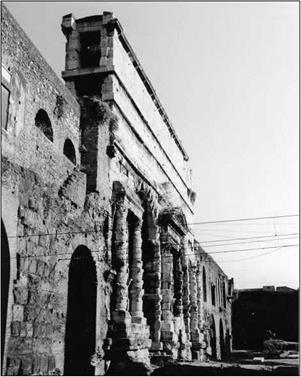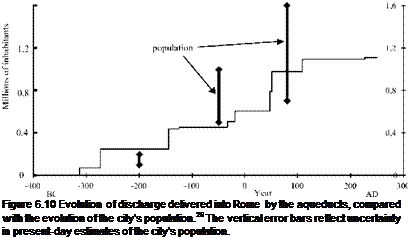The aqueducts of the city of Rome at the end of the 1st century AD
The accession of Nero to supreme power marked the beginning of a somber period for Rome.[228] Civil war followed his assassination in 68 AD, then came the too-short reigns of Vespasianus and Titus. After a promising start, Domitian becomes morbidly suspicious, and sheds the blood of those near to him and his collaborators only to end up being assassinated himself in 96 AD. Then Nerva, an old senator, is chosen as the new emperor in a climate of restoration of the old Roman virtues. We have noted earlier that the Romans placed high symbolic value on water; among the early preoccupations of the new emperor is the restoration of water distribution in the city. For this he calls on a former collaborator and experienced administrator: Sextus Julius Frontinus, 61 years old, former governor of Britain, i. e. Great Britain, and former preconsul of Asia. In 97 Nerva names Frontinus as curator aquarum, translated as “high commissioner for water” of the city of Rome. Frontinus is a methodical man who takes his responsibilities seriously. At the beginning of his service, Frontinus prepares a written description of the aqueducts of the city for his own information and then continues with written descriptions of his observations, measurements, and actions during his tenure. This treatise has come down to us, and we have already cited several extracts. We can learn much about both the characteristics and the history of these aqueducts from Frontinus’ writings (Table 6.2).
The principal aqueducts at the time of Frontinus came from the region of the Sabine mountains; the four largest ones, Anio Vetus, Marcia, Claudia and Anio Novus, came from the valley of the Anio, upstream of Tivoli (the Roman Tibur) (see Figure 6.8). Where this river flows out onto the plain of Rome, at Tivoli, the aqueducts leave the valley of the Anio and trace a large arc in the direction of the Alban mountains, thus maintaining their elevation as they near the city of Rome. On the Frascati heights, they are rejoined by the Tepula and Julia aqueducts, and complete their trajectory to the city on arches. At their entrance into Rome, the Anio Novus flows above the Claudia, on the same arches (Figure 6.9). Similarly, the canal of the Julia is above those of the Tepula and the Marcia, all three superposed on the same arches. These five aqueducts flow on a slope of about 1.3 m/km in their final reaches.[229]
What surely motivated Nerva to put things in order was that the amount of legally distributed water was far less what it was expected to be, as dictated by the written imperial records. The new curator aquaraum therefore took it upon himself to make discharge measurements in the aqueducts, both at their origins and at their points of arrival in the city. To his surprise, he found that now the measured discharges were well above those specified in the official registers. There could only be one conclusion: there had been fraud, greater fraud than had originally been suspected!
Here we must pause to note the significance of discharge for the Romans. Not having understood or recognized the physical concept of water velocity, the Romans found it sufficient to measure the flow cross-section at spots where the water velocity was
|
Table 6.2 The nine aqueducts of Rome in the days of Frontinus (about 100 AD)[230] Two other aqueducts, the Trajana and the Alexandrina, are constructed later. The indicated discharges are estimated from the equivalence: 1 quinariae = 40.6 m3 per day. The total discharge (all but Alsietina) is 977,00 m3/day. |
||||||
|
Name |
Construction Date |
Length (km) and % underground |
Avg Slope (m/km) |
Discharge (i. e. Area) (quinariae) |
Estimated Discharge (m3/day) |
Origin and quality of water |
|
Appia |
312 BC |
16.5 (95%) |
0.6 |
1,825 |
73,000 |
Spring in the Anio valley. Excellent |
|
Anio Vetus |
272 BC |
64 (99%) |
3.6 |
4,398 |
175,900 |
Anio River. Somewhat muddy |
|
Marcia |
144 BC |
91 (88%) |
2.7 |
4,690 |
187,600 |
Captured from springs Excellent |
|
Tepula |
125 BC |
18 (46%) |
5 |
445 |
17,800 |
Captured from groundwater. Warm water |
|
Julia |
33 BC |
22 (54%) |
12.4 |
1,206 |
48,200 |
Springs. Excellent |
|
Virgo |
19 BC |
21 (92%) |
0.2 |
2,504 |
100,200 |
Springs. Excellent |
|
Alsietina |
2 AD |
33 (99%) |
6 |
392 |
15,700 |
Lake Alsietinus nonpotable (used for water games) |
|
Claudia |
47 AD |
69 (78%) |
3.8 |
4,607 |
184,300 |
Springs. Excellent |
|
Anio Novus |
52 AD |
87 (84%) |
3.8 |
4,738 |
189,500 |
Anio River. Muddy |
judged to be neither excessive nor too weak. The Roman unit of discharge, the quinar – ia, is actually just a measure of area (4.2 cm2), whereas everyone knows today that volumetric discharge is the product of the velocity and the cross-sectional area of the canal. What Frontinus really measured is the depth of water in well-defined locations in the canal, from which he deduces the area and therefore calculates his estimate of discharge in quinariae. The discharges shown in table 6.2 are based on a fixed relation between quinariae and real discharges. We will discuss this further at the end of this chapter, regarding the hydraulic knowledge of the Romans. As imprecise as it was, this system nevertheless enabled Frontinus to detect the important deficits and differences described above:
“I do not doubt that many will be surprised that according to our gaugings, the quantity of water was found to be much greater than that given in the imperial records. The reason for this is to be found in the blunders of those who carelessly computed each of these waters at the outset. Moreover, I am prevented from believing that it was from fear of droughts in the summer that they deviated so far from the truth, for the reason that I myself made my gaugings in the month of July, and found the above-recorded supply of each one remaining constant throughout the entire remainder of the summer. But whatever the reason may be, it has any rate been discovered that 10,000 quinariae were intercepted, while the amounts granted by the sovereign are limited to the quantities set down in the records.
“Another variance consists in this, that one measure is used at the intake, another, considerably smaller, at the settling-reservoir, and the smallest at the point of distribution. The cause of this is the dishonesty of the water-men, whom we have detected diverting water from the public conduits for private use. But a large number of landed proprietors also, past whose fields the aqueducts run, tap the conduits; whence it comes that the public watercourses are actually brought to a standstill by private citizens, just to water their gardens.”[231]
This observation is rather severe. Numerous wildcat taps provide a clandestine water supply to those living adjacent to the aqueducts, and support a parallel, unofficial water market. Nearly half of the water delivered to Rome by the aqueducts escapes the official accounting. But what also upsets Frontinus is that water from the different aqueducts is senselessly mixed together without taking into account the quality of the different sources. The last aqueduct built under Claudius, (predecessor of Nero), the Anio Novus, serves to complete the aqueduct system, and its additional supply was useful in obscuring the pilfering:
“The two Anios (aqueducts) are less limpid, for they are drawn from a river, and are often muddy even in good weather, because the Anio, although flowing from a lake whose waters are very pure, is nevertheless made turbid by carrying away portions of its loose crumbling banks, before it enters the conduits (….)
“One of the Anio (aqueducts), namely Old Anio (Anio Vetus), running at a lower level than most of the others, keeps this pollution to itself. But New Anio (Anio Novus) contaminated all the others, because, coming from a higher altitude and flowing very abundantly, it helps to make up the shortage of the others; but by the unskillfulness of the water-men, who diverted into the other conduits oftener than there was any need of an augmented supply, it spoiled also the waters of those aqueducts that had a plentiful supply, especially Claudia, which, after flowing in its own conduit for many milles, finally at Rome, as a result of its mixture with Anio, lost till recently its own qualities. And so far was New Anio from being an advantage to the waters it supplemented that many of these were then called upon improperly through the heedlessness of those who allotted the waters. We have found even Marcia, so
charming in its brilliancy and coldness, serving baths, fullers, and even purposes too vile to „75
mention.
|
Figure 6.8 Layout of the aqueducts of Rome. This map also shows the Trajana and the Alexandrina, built after the magistracy of Frontinus. See Figure 6.36 for the imperial ports. Adjacent: elevations of the aqueducts at their points of arrival in Rome. The Aqua Marcia is shown on a Roman coin (author’s collection). |
Frontinus devotes the three years of his mission to reducing these clandestine diversions, and improving the distribution system, both quantitatively and qualitatively. He restores respect for the quality of consumable water, and moves the intake of the Anio Novus further upstream to capture clearer water. He also improves the reliability of supply to the public fountains, supplying each with two outlets so as to assure continuous supply when work is being done on one of the aqueducts.
25 Ibid., 90-91.

 |
Figure 6.9 The Agua Claudia and the Aqua Anio Novus on the same arches, at the Porta Maggiore of Rome. The aqueduct was integrated into the new city wall under the emperor Aurelius, in the 4th century AD (photo by the author).
26 The discharges are those of table 6.2, after Frontinus. The demographic data are taken from Christol andNauny (1997).
Whatever may have been these problems in managing the system, they did not reflect any fragility in the supply of water to the city. Figure 6.10 shows how the increase in discharge delivered to Rome accompanies the demographic growth. With nearly a cubic meter of water per person per day, a Roman inhabitant had nearly a hundred times more water than his or her counterpart in Paris of the 19th century!
Later, two additional aqueducts are constructed, but they are less well known to us since they came after the writings of Frontinus. They are the Trajana, constructed around 110 AD under the grand Emperor Trajan, successor of Nerva; and the Alexandrina, built under Alexander Severus in 226 AD. From the 2nd century AD, Rome falls into a kind of recession, and its population probably stabilizes. This second century is the century of the provinces, insofar as expansion is concerned. The construction of grand aqueducts begins again in these provinces, in particular in Gaul, Spain, and Africa.







Leave a reply